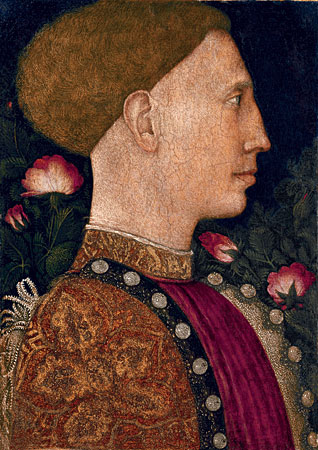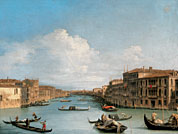Italian art heads for the heights in Lausanne

Great works of Italian art, including the exquisite Portrait of Lionello d'Este by Pisanello, have gone on show in Lausanne.
The unprecedented exhibition at the city’s Fondation de l’Hermitage is almost like a who’s who of Italian Renaissance to 18th century art – Titian, Raphael and Bellini are among those represented.
The pictures all come from the Accademia Carrara in Bergamo in northern Italy and have been loaned to the Hermitage until October 26.
Lionello d’Este’s portrait is familiar to art lovers all over the world. It is considered one of Pisanello’s best works and is one of the Accademia Carrara’s most valuable.
The picture, not larger than an A4 piece of paper, pays loving attention to detail: witness the rose, the light on the pearls and the shading on the subject’s complexion.
The Hermitage, which has just reopened its doors after building work, is aiming to show the Italian masterworks in their best light.
“In the past we have loaned out to London,” Giovanni Valagussa, curator at the Accademia Carrara, told swissinfo.
“But it really is the first time that the most important masterpieces from our collection have all left together.”
A good solution
This was only possible because the Italian museum is currently undergoing an extensive renovation. Loaning out the works is the best way to avoid having to leave the precious paintings in storage, explained Valagussa.
“A museum such as here in Lausanne ensures that you have the best conservation conditions and takes advantage of this extraordinary heritage, which is very famous but is often not associated with Bergamo,” said the curator.
“Few people know that the Portrait of Lionello d’Este – which is almost in every art history book – can be found in a museum in a small town in northern Italy,” he added.
The Hermitage, housed in an 18th century villa, therefore jumped at the chance to host the paintings. The result is a display that is very skilfully laid out, in rooms that are bathed in natural light.
For Valagussa, it is surprising to see the works, which he knows so well, in an 18th century context. This harks back to the beginnings of the collection, which was founded in 1796 after the death of the art-loving Count Giacomo Carrara.
The villa and the fact that most of the pictures are small, having come from private collections, creates an almost family and homely feel, he says and “in some ways is more adapted to these types of works”.
Light and context
The natural light is also a plus as museums tend to use artificial light. “However, natural light allows you to see the pictures much better,” observed Valagussa.
Also impressive is the Hermitage’s surrounding park and lake, which the expert says brings out the colours and light in the paintings.
Overall Valagussa is impressed with the Lausanne display.
“I hope that this exhibition can give an impulse for the future reorganisation of the Accademia Carrara. When it closed the rooms were bursting with paintings placed one against the other,” he said.
“It really opens your eyes to see a selection of these same works in another context. It could help us find other solutions for the museum.”
swissinfo, based on an Italian article by Doris Lucini
“Italian paintings from the Renaissance to the 18th century – treasures from the Accademia Carrara in Bergamo” runs at the Fondation de l’Hermitage until October 26.
Among the master artists on show are Carpaccio, Titian, Canaletto, Botticelli, Raphael and Pisanello.
The exhibition could head to other museums after Lausanne. Talks are currently being held with French museums. Japanese proposals were turned down as curators felt that there was not enough room in the places suggested.
Situated in Bergamo, northern Italy, the Accademia Carrara is a renowned school of fine arts with an associated museum of international importance.
It contains more than 1,800 pictures from the 15th-18th centuries, in particular from the Venetian and Lombard schools.
When Count Giacomo Carrara died in 1796, he left his art collection to the city of Bergamo. This later became the Accademia Carrara. Other collections have been added, notably from Count Guglielmo Lochis (1886) and art historian Giovanni Morelli (1891).
The Accademia Carrara is currently closed for two years while it undergoes restoration work

In compliance with the JTI standards
More: SWI swissinfo.ch certified by the Journalism Trust Initiative


You can find an overview of ongoing debates with our journalists here . Please join us!
If you want to start a conversation about a topic raised in this article or want to report factual errors, email us at english@swissinfo.ch.